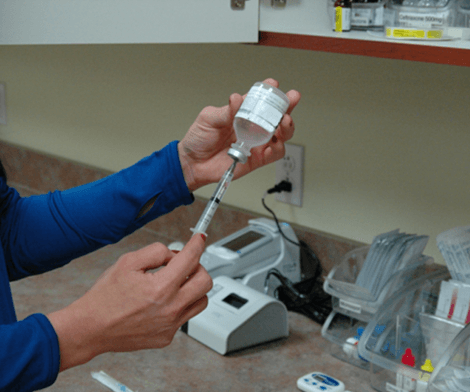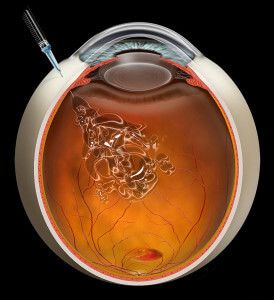
Insight Eye Clinic has been a pioneer in using these injections to treat various eyediseases. These anti VEGF’s have improved visual results in various conditions likeAge Related Macular Degeneration , Diabetic Retinopathy , Vascular Occlusionsetc.There are many types and brands of intravitreal Anti VEGF injections available vizBevacizumab, Ranibizumab, Aflibercept & Brolucizumab to name a few. Your doctorcan counsel you and help you decide the injection best suited for your eye.
For many retinal diseases the only way to get medication to where it is needed is to give an injection into the eye. Eye drops and pills do not deliver a high enough amount of medication to the retina. Injections are the most efficient and safe way of treating many diseases including wet macular degeneration.
Typically intraocular injections don’t hurt. The most common sensation is a slight burning sensation that is related to the antiseptic used to clean the surface of the eye.
If you need an injection of medication drops will be put in the eye to numb the eye and minimize discomfort from the procedure. The eye is carefully cleaned with an iodine solution to reduce the risk of infection. The injection is given using a tiny needle that enters the eye through the white part of the eye (sclera) close to the front of the eye.
An intraocular injection is generally a very safe procedure. Occasionally side effects can occur, most minor and some very serious. Commonly, a spot of bleeding may develop on the surface of the eye at the site of the injection. The bleeding is painless and usually causes no symptoms at all, resolving over a few days. Infections are the most serious risk but only rarely occur. They happen in about 1 out of every 2,000-3,000 injections. Side effects outside of the eye are rare since only a small amount of medication is injected into the eye.

It is important to understand the reason for the injection and the potential risks of the injection. If you have any questions ask your retina specialist.
There are many different types of medications that can be injected into the eye. The list of medications and indications continue to grow every year. Below are a few of the more common medications that are injected into the eye.
Avastin: Avastin is an antibody to vascular endothelial growth factor (VEGF), a protein responsible for angiogenesis (new blood vessel growth). Because of Avastin's ability to bind to VEGF, the VEGF molecule is then unable to bind to its receptor and hence angiogenesis does not occur. Avastin is approved as an anti-tumor medication for use in specific cancer types. Although Avastin is not approved by the FDA for ocular use, it has proved to be highly efficacious for use in cases of retinal or choroidal neovascularization and macular edema. It has been in routine use for eye disease "off label" since 2005.
Lucentis: Lucentis is a modified version of Avastin. Like Avastin, Lucentis binds VEGF which stops VEGF from binding to its receptor and promoting angiogenesis. Lucentis is a smaller and may better penetrate into the retina. Lucentis has specifically been designed for use in the eye to treat neovascular (wet) macular degeneration, among other retinal disease, and is approved for this use by the FDA. The CATT trial has shown that Lucentis and Avastin work to about the same degree for patients with wet macular degeneration.
Triamcinolone Acetonide: Triamcinolone acetonide is a synthetic corticosteroid. Corticosteroids are hormones that are produced naturally by the body. This class of compounds contains the most potent anti-inflammatory drugs available to us. They work by inhibiting certain reactions in cells that are responsible for causing allergic responses and inflammation. Triamcinolone acetonide is a potent and long lasting version of a corticosteroid. Unfortunately, prolonged exposure to corticosteroids can cause high intraocular pressure and induce cataract formation.
Ozurdex: Ozurdex is a long lasting steroid implant that contains dexamethasone. The implant is given by an injection into the eye and can last up to 6 months in some people.side effects like cataract and intraocular pressure rise are less often as compared to Triamcinolone acetonide.
Visit us at Insight Eye Clinic and experience unrivalled professional service from the moment you step in. We offer intravitreal injection in Mumbai for many retinal diseases and assure our clients the highest quality eye care.
